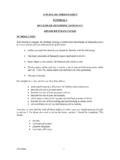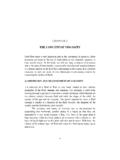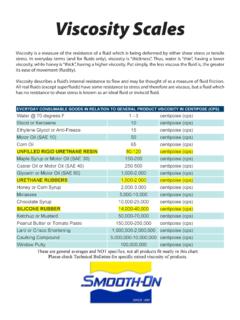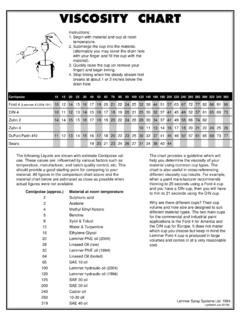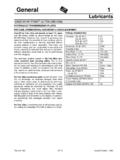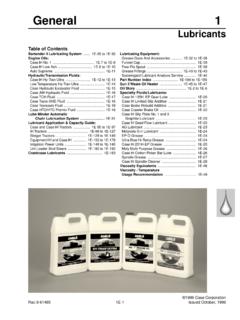Transcription of 1. VISCOSITY - zcu.cz
1 1 TUTORIAL No. 1 FLUID FLOW THEORY In order to complete this tutorial you should already have completed level 1 or have a good basic knowledge of fluid mechanics equivalent to the Engineering Council part 1 examination 103. When you have completed this tutorial, you should be able to do the following. Explain the meaning of VISCOSITY . Define the units of VISCOSITY . Describe the basic principles of viscometers. Describe non-Newtonian flow Explain and solve problems involving laminar flow though pipes and between parallel surfaces. Explain and solve problems involving drag force on spheres. Explain and solve problems involving turbulent flow. Explain and solve problems involving friction coefficient. Throughout there are worked examples, assignments and typical exam questions.
2 You should complete each assignment in order so that you progress from one level of knowledge to another. Let us start by examining the meaning of VISCOSITY and how it is measured. 1. BASIC THEORY Molecules of fluids exert forces of attraction on each other. In liquids this is strong enough to keep the mass together but not strong enough to keep it rigid. In gases these forces are very weak and cannot hold the mass together. When a fluid flows over a surface, the layer next to the surface may become attached to it (it wets the surface). The layers of fluid above the surface are moving so there must be shearing taking place between the layers of the fluid. Let us suppose that the fluid is flowing over a flat surface in laminated layers from left to right as shown in figure y is the distance above the solid surface (no slip surface) L is an arbitrary distance from a point upstream.
3 Dy is the thickness of each layer. dL is the length of the layer. dx is the distance moved by each layer relative to the one below in a corresponding time dt. u is the velocity of any layer. du is the increase in velocity between two adjacent layers. Each layer moves a distance dx in time dt relative to the layer below it. The ratio dx/dt must be the change in velocity between layers so du = dx/dt. When any material is deformed sideways by a (shear) force acting in the same direction, a shear stress is produced between the layers and a corresponding shear strain is produced. Shear strain is defined as follows. dydxdeformed beinglayer theofheight ndeformatio sideways== The rate of shear strain is defined as follows. dydudy dtdxdt takentimestrainshear == == & It is found that fluids such as water, oil and air, behave in such a manner that the shear stress between layers is directly proportional to the rate of shear strain.
4 = & constant x Fluids that obey this law are called NEWTONIAN FLUIDS. 2 It is the constant in this formula that we know as the dynamic VISCOSITY of the fluid. DYNAMIC VISCOSITY = dudyshear of rate stressshear = =& FORCE BALANCE AND VELOCITY DISTRIBUTION A shear stress exists between each layer and this increases by d over each layer. The pressure difference between the downstream end and the upstream end is dp. The pressure change is needed to overcome the shear stress. The total force on a layer must be zero so balancing forces on one layer (assumed 1 m wide) we get the following. dLdpdyd0dL d dy dp = = + It is normally assumed that the pressure declines uniformly with distance downstream so the pressure gradient dLdpis assumed constant.
5 The minus sign indicates that the pressure falls with distance. Integrating between the no slip surface (y = 0) and any height y we get ) (..22dyuddLdpdydyduddyddLdp = == Integrating twice to solve u we get the following. BAyudLdp2yAdydudLdpy2++ = + = A and B are constants of integration that should be solved based on the known conditions (boundary conditions). For the flat surface considered in figure one boundary condition is that u = 0 when y = 0 (the no slip surface). Substitution reveals the following. 0 = 0 +0 +B hence B = 0 At some height above the surface, the velocity will reach the mainstream velocity uo. This gives us the second boundary condition u = uo when y = . 3 Substituting we find the following.
6 + = + = = + = oo2oo2udLdp2yuyudLdp2udLdp2yhence udLdp2 AAudLdp2 Plotting u against y gives figure BOUNDARY LAYER. The velocity grows from zero at the surface to a maximum at height . In theory, the value of is infinity but in practice it is taken as the height needed to obtain 99% of the mainstream velocity. This layer is called the boundary layer and is the boundary layer thickness. It is a very important concept and is discussed more fully in later work. The inverse gradient of the boundary layer is du/dy and this is the rate of shear strain . 4 5 UNITS of VISCOSITY DYNAMIC VISCOSITY The units of dynamic VISCOSITY are N s/m2. It is normal in the international system (SI) to give a name to a compound unit.
7 The old metric unit was a and this was called a POISE after Poiseuille. The SI unit is related to the Poise as follows. 10 Poise = 1 Ns/m2 which is not an acceptable multiple. Since, however, 1 Centi Poise (1cP) is N s/m2 then the cP is the accepted SI unit. 1cP = N s/m2. The symbol is also commonly used for dynamic VISCOSITY . There are other ways of expressing VISCOSITY and this is covered next. KINEMATIC VISCOSITY This is defined as : = dynamic VISCOSITY /density = / The basic units are m2/s. The old metric unit was the cm2/s and this was called the STOKE after the British scientist. The SI unit is related to the Stoke as follows. 1 Stoke (St) = m2/s and is not an acceptable SI multiple. The centi Stoke (cSt),however, is m2/s and this is an acceptable multiple.
8 1cSt = m2/s = 1 mm2/s OTHER UNITS Other units of VISCOSITY have come about because of the way VISCOSITY is measured. For example REDWOOD SECONDS comes from the name of the Redwood viscometer. Other units are Engler Degrees, SAE numbers and so on. Conversion charts and formulae are available to convert them into useable engineering or SI units. VISCOMETERS The measurement of VISCOSITY is a large and complicated subject. The principles rely on the resistance to flow or the resistance to motion through a fluid. Many of these are covered in British Standards 188. The following is a brief description of some types. U TUBE VISCOMETER The fluid is drawn up into a reservoir and allowed to run through a capillary tube to another reservoir in the other limb of the U tube.
9 6 The time taken for the level to fall between the marks is converted into cSt by multiplying the time by the viscometer constant. = ct The constant c should be accurately obtained by calibrating the viscometer against a master viscometer from a standards laboratory. REDWOOD VISCOMETER This works on the principle of allowing the fluid to run through an orifice of very accurate size in an agate block. 50 ml of fluid are allowed to fall from the level indicator into a measuring flask. The time taken is the VISCOSITY in Redwood seconds. There are two sizes giving Redwood or seconds. These units are converted into engineering units with tables. FALLING SPHERE VISCOMETER This viscometer is covered in BS188 and is based on measuring the time for a small sphere to fall in a viscous fluid from one level to another.
10 The buoyant weight of the sphere is balanced by the fluid resistance and the sphere falls with a constant velocity. The theory is based on Stokes Law and is only valid for very slow velocities. The theory is covered later in the section on laminar flow where it is shown that the terminal velocity (u) of the sphere is related to the dynamic VISCOSITY ( ) and the density of the fluid and sphere ( f and s) by the formula = F gd2( s - f)/18u F is a correction factor called the Faxen correction factor, which takes into account a reduction in the velocity due to the effect of the fluid being constrained to flow between the wall of the tube and the sphere. ROTATIONAL TYPES There are many types of viscometers, which use the principle that it requires a torque to rotate or oscillate a disc or cylinder in a fluid.
